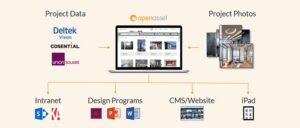The Future of Work
Jul 30, 2019

The discussion about the future of the workplace, and how technology will change the future of work, isn’t a straightforward subject to address. The conversation is split between thinkers dreaming of new ways technology will improve the workplace, and those concerned with the social impact of changes.
Regardless of personal feelings on issues such as digital transformation, the future of work has already begun in earnest. The undeniable fact is that change is already happening. This change will affect individuals and companies alike; those best placed to weather the sea change will be the ones that prepare in advance.
What is driving the workplace change?
Although how things will look in the future is far from an exact science, companies can ensure they are ready for that future by embracing change now.
The modern workplace is always in a constant state of change, but the pace of evolution is now is faster than ever. Some of the main factors creating the need for change include:
Technology & Digital Transformation
The introduction of automation and AI is removing some jobs and occupations from the market. Other jobs may be partially affected, with changes to employee day to day work and the addition of new tasks. Both companies and individuals must prepare for these changes to avoid being left behind.
Digital transformation is about the modernization of the workplace and the delivery of improved customer experience. It is a coming together of technology and people to create new ways of working, bringing with it new mindsets at all levels in a business. For many people, they should see technology as an augmentation to their existing job, rather than a threat.
There is already evidence of a growing divide between companies adopting new working practices and technology, and those that are struggling with the concept of digitization, let alone keeping pace with the former.
Changing workforce demographics
Baby boomers and Gen Xers might have set many of the existing norms in the workplace, but baby boomers are retiring, and Gen X is in mid to late-career. With older millennials moving to management roles and Gen Z entering the job market, expectations are changing.
Arbitrary notions of “this is how things are done” tied to workers that have retired from the job market are unlikely to be tolerated by the newer generations. The workplace generational gap between baby boomers and gen Z is vast; this means that management needs to accept new practices and environments to attract the right talent.
Employee expectations & aspirations
With the changing demographics comes new career expectations and aspirations. At the forefront of these expectations are a better work-life balance, job satisfaction, regular opportunities to improve skills and learn new ones, collaboration with others, and frequent feedback.
Companies need to be aware that younger generations will choose employers more carefully. Greater importance will be placed on the working environment, day-to-day work experiences, and companies with a social conscience. It is also expected that a premium will be placed on job stability and commitment to employers, so long as staff feel valued, and opportunities for career advancement are available.
Wellbeing & Workplace Satisfaction
Wellbeing in the workplace is a high importance topic at all levels. A positive working environment has long been proven to encourage productivity – the University of Warwick found that happy workers are 12% more productive. It is now the case that positive workplaces are as important as a job role and salary when selecting an employer. Other drivers of workplace satisfaction include:
- Job purpose and meaning
- Well designed working environment
- Support
- Good communication
- Engaged and trustworthy manager
- Company integrity
- Customer expectations
New trends and customer expectations, in both B2B and from consumers, is driving companies to change the way they do business. Digital transformation is at the forefront of the move to a more customer-focused business model.
Changing Skill Sets
A common concern about the changing workplace is the loss of jobs to automated processes. Research shows that, on average, 14% of jobs are at risk from automation with potential for a further 32% to be affected in some way.
While it is inevitable that jobs will be lost, new jobs will be created. In the 20 years between 1995 and 2015, 20% of manufacturing jobs disappeared, but during the same period jobs in the service sector rose by 27%.
Although 40% of new jobs between 2005 and 2016 were created in digitally intensive sectors, it does not mean that all workers can simply transition from one industry or role to another.
Many people are at risk of being left behind due to a lack of relevant skills, with the lowest skilled workers most at risk. These people will need new skills and training to maneuver into new jobs or occupations.
Continuous Learning
Gen Zers entering the workplace for the first time will expect to develop their skill sets on the job. Some skill sets that previous generations take for granted may even need to be developed from scratch. Just as there is much change happening now, Gen Zers understand that their jobs will change throughout their working life. This means that they expect to be in a continuous learning cycle throughout their careers.
LinkedIn research shows that 62% of Gen Zers want to learn in order to improve at their job. But at the same time, it is reported that 67% of Gen Xers say they would like additional guidance to help their careers. Companies cannot expect to deliver the same training across generational gaps; companies will likely need to personalize learning preferences. Training programs should look at providing both soft and hard skills learning via traditional means and technology-based independent learning routes.
Leadership skills and management training
As digital transformation brings more autonomy at a company grassroots level and diffuses decision-making throughout an organization, the ability to make confident, independent judgments will be vital. Traditional hierarchies will be less prevalent in the future. Project work and cross-team collaboration will feature more heavily, meaning that individuals not in management grade roles may be required to lead in some situations.
This means all workers will need to learn soft skills to enable them to influence others in collaborative situations, resolve conflicts, and day-to-day people management.
Technology
While much of the discussion about the future of work focuses on concern about potential job-losses (which is a valid topic for debate), for the working lives of many employees, technology will augment jobs. Augmentation may happen in small ways such as the introduction of time-saving apps, to huge physical technologies that significantly alter jobs.
Productivity
A workplace technology that’s already widely adopted is the productivity tool. Productivity tools could mean a team communication tech, such as Slack, or task management tools such as Monday. These tools can mean less time on email or fewer time-consuming meetings.
As AI and machine learning advances, productivity and communication tools will get smarter. In the not too distant future, you can expect productivity tools to automatically update based upon your activity and chatbots that communicate information to other teams.
While remote working is not a new concept (70% of professionals already work remotely for at least one day a week), communication tools and the ‘Internet of Things’ will bring new ways for people to work remotely. The introduction of faster broadband speeds and connectivity through 5G will help to facilitate these new technologies.
Flexible IT experiences
In the future, the ironclad grip of the IT department on what applications employees can and can’t use will see some flexibility. As employees become increasingly autonomous and look for better ways to collaborate, many tools sanctioned by IT departments will not be fit for purpose. Many employees will look at the productivity applications available for answers.
IT teams will need to adapt to changing workplace technology requirements and allow people to personalize their workflow with tools that suit the needs of their day-to-day workload.
Workspace
Increased collaboration and new technology will shape the way our working environments change. Although the open-plan office has been around a long time, it can still be an oppressive environment if not designed well. The workspace will become more fluid; the removal of some large meeting spaces, increased capacity for hot-desking, the introduction of hubs, and hangouts with the connectivity that enables collaborative working. The need for expensive static AV equipment will be a thing of the past, replaced with new tech that can change any space into a meeting area.
Read more about how workspaces are chaning in our blog ‘The Digital Workplace‘.
Technology in AEC
In AEC, entrepreneurs are already looking to the future and starting to work on solutions now. As well as the other changes described here, the AEC industry will continue to lean heavily on new technology, both on and off-site.
Virtual Reality and Augmented Reality
The use of Virtual Reality (VR) and Augmented Reality (AR) in AEC opens up new ways for firms to visualize designs, both in the studio and on-site. It offers firms new ways of marketing their business to clients at the conceptual and in-progress stages of a project.
Although VR has been around for some time now, the cost of VR is dropping to the point where it’s no longer prohibitively expensive to utilize. This price drop, combined with the availability of wireless VR tech, means it’s set to become an essential piece of tech for every AEC firm.
Blockchain
As with any industry where keeping an accurate log of all transactions is vital, Blockchain technology will become widely used in the AEC industry. Building Information Modelling (BIM) is becoming commonly used in AEC. Blockchain can be applied to BIM to help track the information exchanged between the companies and individuals involved in a construction project.
Cloud-based Technology
A key element of digital transformation is the move to more efficient IT structures. Cloud-based computing allows AEC firms to share data effectively. Cloud-based solutions give people more convenient access to essential software, and reduces the cost of purchasing and maintaining expensive IT infrastructure.
Robotic Technology
Thirty years ago, the concept of an exosuit helping a manual labor process was the thing of science fiction. However, robotic technology designed to help workers on-site is becoming a thing of science fact. Robotics companies are developing mechanized suits that will enable single workers to carry out manual tasks not previously possible. Technology such as robotic exosuits will be one of many new pieces of tech designed to make construction safer and introduce new ways of managing routine tasks on-site.





